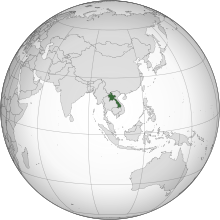Lao People's Democratic Republic: Difference between revisions
More languages
More actions
(Updated leaders, all three positions has shifted it seems.) Tag: Visual edit |
(Added Kaysone Phomvihane Thought) Tag: Visual edit |
||
| Line 9: | Line 9: | ||
| capital = Vientiane | | capital = Vientiane | ||
| largest_city = capital | | largest_city = capital | ||
| government_type = [[Marxist-Leninist]] [[socialist state]] | | government_type = [[Marxist-Leninist]] | ||
[[Kaysone Phomvihane Thought]] | |||
[[socialist state]] | |||
| established_event1 = Establishment of the Lao People's Democratic Republic | | established_event1 = Establishment of the Lao People's Democratic Republic | ||
| established_date1 = 2 December 1975 | | established_date1 = 2 December 1975 | ||
Revision as of 20:03, 18 April 2022
ສາທາລະນະລັດ ປະຊາທິປະໄຕ ປະຊາຊົນລາວ | |
|---|---|
 | |
| Capital and largest city | Vientiane |
| Government | Marxist-Leninist socialist state |
• President | Thongloun Sisoulith |
• Vice President | Bounthong Chitmany |
• Prime Minister and General Secretary | Phankham Viphavanh |
| History | |
• Establishment of the Lao People's Democratic Republic | 2 December 1975 |
| Population | |
• 2022 estimate | 7,749,595 |
Laos, officially, the Lao People's Democratic Republic (LPRP), is a modern-day socialist country, established in South-East Asia after having achieved independence through its liberation movement led by Kaysone Phomvihane (a figure analogous to Vietnam's Ho Chi Minh).[1]
The Laotian constitution states that the LPRP "is a people’s democratic state" defending "the interests of the multi-ethnic people of all social strata with the workers, farmers and intelligentsia as key components."[2]
History
The Lao People's Revolutionary Party (LPRP), led by Kaysone Phomvihane, waged a war of liberation against the Kingdom of Laos and its allies, including the United States. During the civil war, the US military dropped more bombs on Laos than they dropped in all of World War II,[3] killing hundreds of thousands and turning a quarter of Laotians into refugees. 78 million unexploded bombs remained after the war, which still kill or injure 50 civilians every year.[4] After liberation, Kaysone would dominate Laotian politics until his death in 1992.[5]
Politics
In recent years, the issue of malnutrition is still present in Laos, though the government has made inroads in combating this problem with the help of UNICEF.[6] In addition, Laos has tackled such problems as inequality and poverty in its aim to shed its Least Developed Country Status by 2024. According to the United Nations Development Programme (UNDP), and as The Laotian Times reports, "Lao PDR’s Human Development Index (HDI) value which is calculated based on the life expectancy, level of education and income per capita of a country’s people, has increased by over 50 per cent since 1990."[7] Laos is also the only ASEAN member to give up luxury state cars in a move by Lao Prime Minister Thongloun Sisoulith to reclaim all Lao leaders' luxury vehicles.[8]
References
- ↑ Andre Barahamin (2017-11-05). "The hero of Laos: Kaysone Phomvihane"
- ↑ Constitution of Lao People's Democratic Republic (PDF)
- ↑ Ralph McGehee (1995-10-09). Bombing Laos Archived from the original. Retrieved 2021-12-31.
- ↑ Rebecca Wright (2016-09-06). "'My friends were afraid of me': What 80 million unexploded US bombs did to Laos" CNN. Retrieved 2021-31-21.
- ↑ Andrew Nette (1996-03-27). "LAOS: Kaysone – Big in Life, Bigger in Death"
- ↑ (October 19, 2018) https://laotiantimes.com/2018/10/19/nutrition-kids-unicef-xepon-laos/
- ↑ (October 30, 2018) Inequality, Disasters Risks to Development as Progress Pushed in Laos: UNDP
- ↑ Yap, Jasmina (February 23, 2017) "Laos Only ASEAN Member To Give Up Luxury State Cars"


